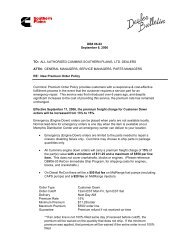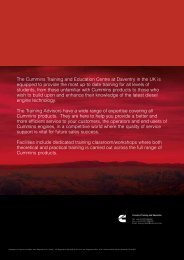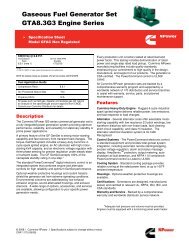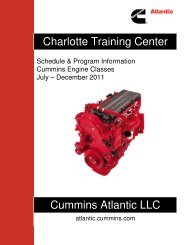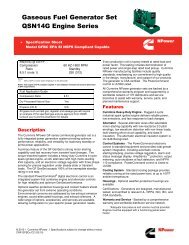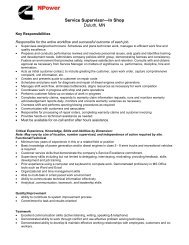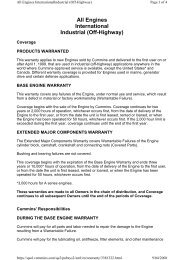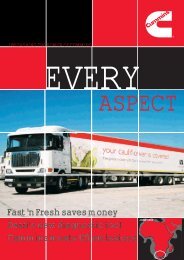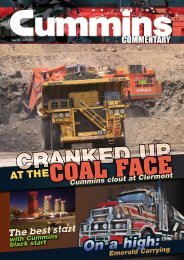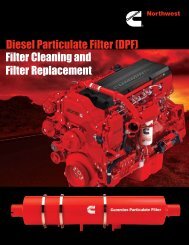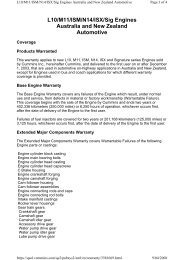LONG
Cummins Commentary
Cummins Commentary
- No tags were found...
Create successful ePaper yourself
Turn your PDF publications into a flip-book with our unique Google optimized e-Paper software.
EVERY<br />
UPDATE<br />
11<br />
Swiftly to the<br />
rescue<br />
A $1 million Cummins-powered<br />
vessel has set a new benchmark<br />
for Coastguard operations in<br />
New Zealand.<br />
Coastguard Hawke’s Bay is one of 67 volunteer<br />
Coastguard units stationed around New Zealand.<br />
Based in Napier on the North Island’s east coast,<br />
the Hawke’s Bay unit was awarded ‘Performance of<br />
the Year’ in 2009 by the national Coastguard body<br />
for its outstanding rescues.<br />
Coastguard New Zealand described the efforts of<br />
the Hawke’s Bay team as an “outstanding example”<br />
of commitment and heroism.<br />
Long time Coastguard<br />
skipper Alex Smith<br />
wanted Cummins because<br />
it’s a “well known, well<br />
proven” brand.<br />
In mid-2009, Coastguard Hawke’s Bay launched its new<br />
$1 million rescue vessel to service one of the largest<br />
operational Coastguard areas in the country.<br />
The 11.7-metre QRV (quick response vessel), designed for<br />
a crew of four to six, is powered by twin 480 hp Cummins<br />
QSB engines driving through waterjets from HamiltonJet.<br />
With a fuel capacity of 1100 litres, the vessel has a range<br />
of 230 nautical miles at a cruise speed of 30 knots. Top<br />
speed is 38 knots.<br />
The vessel, which also acts as a backup pilot boat for<br />
the Port of Napier, is named after the late Celia Knowles,<br />
a Napier resident and keen seafarer whose estate of over<br />
$400,000 assisted the building of the craft.<br />
Long time Coastguard skipper Alex Smith had a clear<br />
idea of what the ideal boat would look like.<br />
His investigations took him to Tauranga’s AMF Boat<br />
Company and together with designer David de Villiers,<br />
they finalised the specs for the new vessel which would<br />
replace an 8.5-metre trailer boat with twin outboards<br />
which had been in use since 1997.<br />
Smith selected Cummins because “it is a well known,<br />
proven brand” with good parts and service availability<br />
in the area.<br />
He points out the electronic 5.9-litre QSB<br />
diesels are also exceptionally quiet.<br />
“When a crew is at sea for hours at a time<br />
in tough conditions and things get tense, the<br />
non-stop drone of engines can be sapping.<br />
Low noise is a huge bonus for rescue crews,”<br />
he asserts.<br />
There may only be a muted throb from the<br />
Cummins diesels, but importantly they offer<br />
plenty of reserve power, so if the Coastguard<br />
has to get to a scene in hurry, it can.<br />
The vessel is an RIB (rigid-hulled inflatable boat)<br />
design using heavy-duty Hypalon tubes.<br />
“The primary job of the Coastguard is rescuing<br />
people and the soft tubes make this easier when<br />
you have to pull people up over the sides,” says<br />
Alex Smith.<br />
The tube system also<br />
provides reserve buoyancy<br />
and acts as a fender when<br />
manoeuvring alongside<br />
another vessel.<br />
The use of waterjets was<br />
another key requirement.<br />
“Spinning props are very<br />
dangerous when retrieving<br />
people from the water, so<br />
the waterjets eliminate<br />
that issue,” Smith points<br />
out. “The jets also give us<br />
the ability to operate in<br />
very shallow water.”<br />
The quality of workmanship in the Coastguard vessel is<br />
obviously very high.<br />
Tauranga-based AMF (Aluminium Marine Fabricators),<br />
established in 1984, builds a range of aluminium<br />
pleasure and workboats from 5.8 to 14 metres. Its easy<br />
to understand why its RIB vessels are popular with<br />
Coastguard units around New Zealand.<br />
Coastguard Hawke’s Bay vessel, powered by twin 480 hp<br />
Cummins QSB engines, has a top speed of 38 knots.



